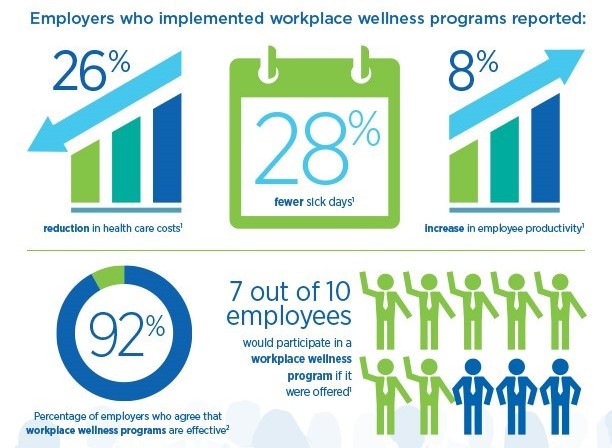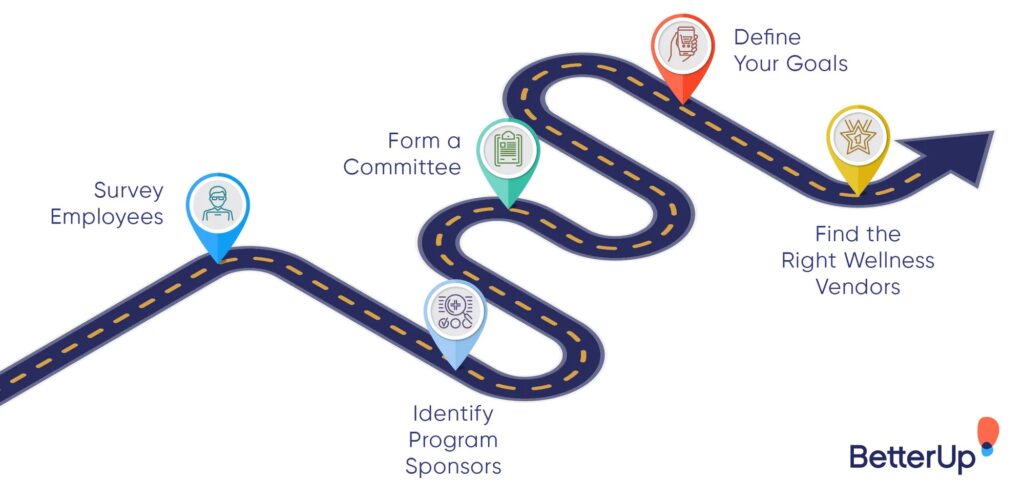In the constant pursuit of productivity, growth, and profit, sometimes we forget that our health and well-being are the fuel that gets us there. Though oftentimes, it’s only when our low-fuel warning light starts flashing that we start to take notice. But by the time we’re running on fumes, filling up the tank becomes costly, and sometimes the vehicle breaks down altogether.
Analogies aside, there is an undeniable link between employee health and well-being and a company’s success. Onsite employee health programs, once considered a perk or a nice-to-have, are fast emerging as not only a critical hand in emergencies but also a strategic differentiator that influences everything from talent acquisition to the bottom line.
In this blog, we’ll cover just how they are influencing today’s business operations, particularly in industries like construction, their key components, and how to successfully implement these programs.
The Impact of Employee Health on Business Performance
When employees aren’t at their best, this causes a ripple effect across the company that is felt in more ways than one. The most obvious impact is financial costs from medical expenses. In industries like technology, common hazards in data centers, such as ergonomic strains or inadequate ventilation, can exacerbate absenteeism and presenteeism, leading to missed deadlines and reduced output.
A study by the Integrated Benefits Institute found that poor employee health costs the U.S. economy $530 billion annually in lost productivity alone.
All the direct and indirect costs, both short-term and long-term, very quickly add up. But having onsite healthcare and wellness solutions that go beyond conventional occupational health clinics presents an opportunity to change this narrative, and it’s proving to be a catalyst for positive change in several different ways.
Reducing Sick Days
The more accessible healthcare is, the more likely employees are to seek it out when they first start feeling unwell or notice an issue. Instead of trying to tough it out and potentially getting worse, they can receive care there and then. When health concerns are addressed promptly, they’re less likely to escalate into something that requires extended time off work. Additionally, many programs often include preventative care and wellness initiatives, all which curb injury and illness issues and drive town sick days.
Improving Employee Productivity, Engagement, and Morale
Healthier employees are simply more productive. Not only are they physically more capable, but their mental clarity and emotional well-being are also improved. This leads to better decision-making, stronger problem-solving skills, and a higher level of engagement with their tasks. Beyond that, having dedicated onsite health professionals sends a clear message to employees: “Your well-being is valued.” This investment in their health can boost morale and make employees feel appreciated. They see that their employer cares about them as individuals, not just as workers. This sense of being valued can lead to increased loyalty, engagement, and ultimately, a stronger commitment to their roles.
Reducing Costs and Bringing Financial Benefits
The benefits of onsite health clinics don’t just extend directly to the workforce; they also present an opportunity for businesses to cut unnecessary expenditures. As anyone in the industry knows, the cost of workplace injuries and illnesses can rack up heavily and fast.
Firstly, by keeping employees healthier and reducing absenteeism, the company doesn’t have to allocate funds towards hiring temporary replacements or paying overtime to existing staff.
Secondly, in preventing minor health issues from escalating into major ones, ultimately saving the company from hefty medical bills associated with emergency room visits and hospitalizations, as well as potential litigation. This, in turn, contributes to the ROI of employee health programs by lowering insurance premiums as the company’s risk profile improves.
Thirdly, the convenience factor also comes into play. Instead of employees taking hours out of their workday to travel to and from appointments, onsite care reduces this lost time significantly. Finally, the enhanced morale and loyalty aspect can lead to reduced employee turnover, sparing the company from the significant expenses associated with recruiting and training new staff.
Establishing Competitive Advantage in Talent Acquisition
In the fight for top talent, companies are finding that traditional perks are no longer enough. Employees seek more than just a paycheck; they want employers who invest in their overall well-being. Onsite employee health programs are emerging as a powerful tool to attract and retain talent.
These programs show potential hires that a company cares about its employees as whole people, not just workers. It signals a forward-thinking culture that values health and work-life balance. This image can be a major draw for individuals seeking a fulfilling and supportive workplace.
Moreover, they can help companies stand out in a crowded job market. When other companies offer similar salaries and benefits, a unique offering like this can be a deciding factor for top candidates. It positions the company as an employer of choice, making it easier to attract the best and brightest.
Keeping Up with Compliance
Onsite healthcare also plays a big part in keeping a company compliant with workplace health and safety regulations. For example, regular health checks and screenings, such as drug and alcohol tests, and physical exams can help identify potential hazards early on. This allows for timely interventions, reducing the risk of accidents and injuries. When health issues show up, the onsite professionals can help with the necessary paperwork and managing cases, making sure everything follows the rules, thereby lowering their chances of facing fines or legal issues due to non-compliance.

How to Successfully Implement an Onsite Employee Health Program
Creating and implementing employee onsite health services programs that prove to be effective involves several important steps:
1. Assess Employee Health Needs
Before launching any health initiative, it’s important to get a clear picture of what is needed.
- Conduct Employee Surveys and Interviews
Start by directly asking your employees what matters most to them. Anonymous surveys can create a safe space for honest feedback about their health concerns, interests, and preferences for health services. - Analyse Health Insurance Claim
Examining your health insurance claims can reveal patterns and trends in common health issues among your workforce. This data can help you identify areas that need the most attention and tailor your program accordingly. - Conduct General Health Screenings
Collaborating with healthcare professionals to do cursory onsite employee health screenings can provide a more detailed snapshot of your employees’ overall health status. This can uncover hidden health needs and allow for personalized recommendations.
2. Selecting the Right Healthcare Partner
Once the groundwork is laid, it’s time to implement the program.
- Set Up Infrastructure
Prepare your facility with the necessary medical equipment and spaces for consultations and treatments. This might include medical examination rooms, wellness centers, and emergency response stations. - Communicate with Employees
Clearly communicate the available health services to your employees and explain how they can access these services. Use multiple channels such as emails, intranet, and staff meetings to ensure everyone is informed. - Monitor and Evaluate
Regularly assess the effectiveness of the health program by collecting employee feedback and tracking health outcomes. Use surveys, health metrics, and feedback sessions to gather data and make necessary adjustments. Monitoring key performance indicators (KPIs) such as reduced absenteeism, increased productivity, and improved health outcomes will help in evaluating the program’s success.
3. Ensure Regulatory Compliance and Safety
Legal and safety considerations must be strictly adhered to.
- Abide by OSHA Standards
Ensure your program meets or exceeds OSHA standards. This includes proper documentation, regular safety audits, and compliance with health standards. - Implement Safety Protocols
Establish clear safety protocols for handling medical emergencies and protecting patient privacy, such as setting up emergency response procedures, training staff on first aid, and ensuring confidential handling of health records. - Regular Updates
Continuously review and update safety measures to stay aligned with current regulations and best practices. However, also make certain that you keep up to date with changes in health and safety laws to ensure ongoing compliance.
4. Expanding Services Based on Feedback
As time goes on, you’ll likely find opportunities to expand and improve it. Continuous improvement ensures that the program remains relevant and effective.

Conclusion
As we’ve seen, these programs are becoming more than just a band-aid for workplace injuries or a quick fix for the common cold. They represent a commitment to whole employee health, recognizing that employees are more than just their job titles.
Not only that, but they also touch almost every facet of a company’s operations. It’s becoming clear that companies that invest in their workers are investing in their own success. As the saying goes, “An ounce of prevention is worth a pound of cure.” And when it comes to onsite employee health, that ounce of prevention can translate into pounds of profit, productivity, and overall well-being for employees and the company.
And as we move forward, we can expect to see these programs evolve even further. With advancements in technology and a growing understanding of the importance of holistic health, they will likely become even more comprehensive, advanced, and in-depth.
Interested in finding out what JobsiteCare’s onsite solutions have to offer?
Feel free to contact us.
Frequently Asked Questions
What are onsite health services?
Onsite health services bring healthcare directly to the workplace. This can encompass a range of offerings, from basic health assessments and screenings to more comprehensive care like primary care visits, chronic disease management, and even some urgent care services.
How can onsite employee health screenings improve injury prevention?
Onsite health assessments identify potential health risks and vulnerabilities within a workforce. By understanding these risks, businesses can implement targeted interventions, such as ergonomic adjustments, safety training, and physical therapy, to prevent injuries before they occur. For example, assessments might reveal musculoskeletal issues in employees with physically demanding jobs, allowing for early intervention and preventative measures to reduce the risk of workplace injuries.
How do I select the right onsite healthcare provider for my workforce?
Look for a provider that offers services aligned with your employees’ needs. Consider their experience with similar industries, the comprehensiveness of their services (from acute care to wellness programs), and their ability to adapt to the unique requirements of your workforce.
What are the key components of an onsite health program?
An effective onsite employee health program typically includes a combination of elements. These may include preventive care services like health screenings and vaccinations, health education and coaching, and access to primary care providers.
Can small businesses afford onsite health services?
While traditionally associated with larger companies, onsite health services are becoming increasingly accessible for small businesses. Many providers offer scalable solutions that can be adapted to fit different budgets and company sizes. It’s worth exploring the options available to see if they align with your resources.
How can my business measure the ROI of onsite healthcare?
Measuring the ROI of onsite healthcare involves tracking various metrics, such as reductions in absenteeism and healthcare costs, and improvements in productivity and employee satisfaction. By comparing these metrics before and after implementing the program, businesses can gain a clearer understanding of the financial and operational impact of their investment in employee health.
What is the role of technology in onsite health services?
Technology plays a major role in improving the efficiency and accessibility of onsite health services. Electronic medical records, telemedicine platforms, wearable devices, and health apps streamline communication, data collection, and patient engagement.


